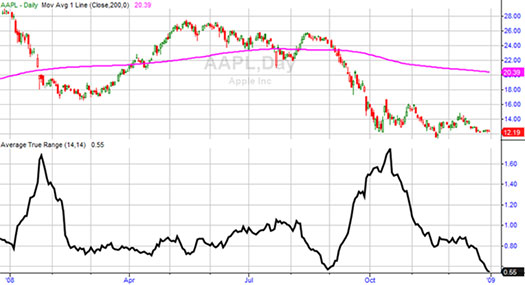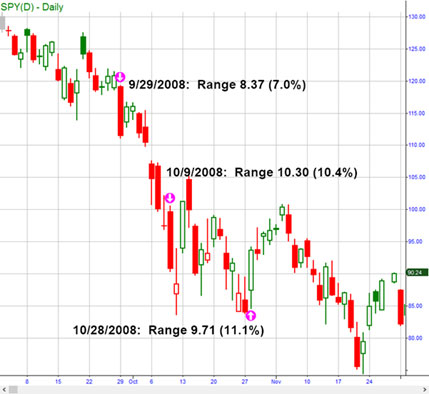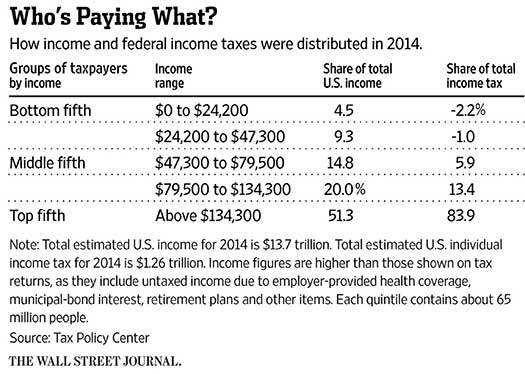Tharp's Thoughts Weekly Newsletter
-
Article: Volatility in Bear Markets by Mark McDowell
-
Workshops: First Oneness Event This Year Coming in June
-
Tip: U.S. Tax Stats—Where Do You Fit? by D. R. Barton, Jr.
-
Back-to-Back Systems Workshops in May
Forex Trading Systems and Trading in a Bear Market
Forex Trading and Live Forex Trading with instructor Gabriel Grammatidis
Have you seen the headlines about currency rate fluctuations?
Does trading Forex seem different enough from your current market that you've stayed away from it?
Join us for these two workshops and leave prepared to trade the system right away.
Learn three forex trading systems and experience trading them live. This is a unique forex workshop that combines the skill and knowledge of an experienced Forex trader with the core principles of Tharp Think.
Trading in a Bear Market with instructor Mark McDowell
How or when will you know the market has turned truly bearish? If we were to find ourselves in a bear market, are you prepared for the powerful psychology? Do you have systems ready to trade the unique market conditions? Super Trader graduate, Mark McDowell will help you understand bear markets and how to profit from them in the upcoming Trading in a Bear Market Workshop.
| • |
|
Study in depth the concept of a bear market. |
| • |
|
Learn what a bear market truly is and learn several ways to define and measure the bear market type. |
| • |
|
Know when a bear market type might be starting and how to know when it might end. |
| • |
|
Learn 5 trading strategies suited for bear market conditions. |
| • |
|
Learn how options can be especially useful for bear market types. |
To register or to see the full workshop schedule, click here.
Feature Article
 Volatility in Bear Markets
Volatility in Bear Markets
by Mark McDowell
View on-line to resolve formatting problems
One of the common characteristics of bear markets is high volatility. Volatility is a measure of the fluctuations in prices. A stock with wide-ranging price fluctuations has higher volatility than a stock with price fluctuations that occur in a narrow range or band.
There are numerous ways to measure volatility. VIX futures are based on the implied volatility in S&P index options and reflect the volatility of the S&P500 (SPX). Average True Range (ATR) measures the fluctuations in an individual stock or ETF. ATR measures the daily range (high - low) and accounts for gaps that occur in stock prices.
In a bear market, volatility can be twice as high as it would typically be during a bull market. Bull markets are most frequently "normal" or "quiet" compared to bear markets, which are usually "volatile".

For example, during the last bear market in US stocks, there were several days when the daily range (from low to high) was 8%-10% in October 2009. Think about that - in a bull market a 10% correction might happen a few times a year. In a bear market, a 10% move in the market might occur once a week or more.
But the volatility in a bear market isn't just reflected in stock prices moving down. Volatility means prices move down, as well as up. In 2009, stock prices also moved up 8%-10% or more on several days.

As markets shift from bull quiet to sideways to bull volatile, it plays havoc with traders' psychology. If traders don't recognize the shift is underway, then they may continue trading systems designed for bull markets during the bear market. That usually results in losses and creates the perception the system doesn't work any longer.
And a trader's psychology is affected by the impact a declining market has on his/her portfolio. Research shows that losses have a much more powerful effect on us psychologically than gains. As volatility increases, with stock prices moving up and down like a roller-coaster, it exacerbates the feelings and emotions of fear and panic. The familiar, comfortable feeling that comes from trading successfully in a bull market is replaced with fear, doubt and, in some cases, panic.
The increased volatility in bear markets is one of the main reasons that trading systems designed for bull or sideways markets are unlikely to be effective. Traders need trading systems designed for bear markets to take advantage of the unique characteristics of bear markets.
To illustrate the difference, imagine a long-only swing trading system that buys stocks on pullbacks, typically holds a position for several days or weeks, and then sells when the stock reaches a point of prior resistance. In a bull market, volatility is "normal" and the trader can place a protective stop below the pullback low. It's common to find setups that offer a reasonable 3:1 or higher reward to risk ratio.
By comparison, a swing system in a high volatility bear market is very difficult to trade. While prices may rise during a bear market, the primary trend is down, so trading from the long side is not effective. If one were to reverse the rules, and trade from the short side, the volatility makes it difficult to find setups with a reasonable reward to risk ratio because the protective stops have to be far from the entry.
The characteristics of bear markets are very different from bull markets. That’s why it’s so important to have trading systems designed to be effective in bear markets.
Would you like to have trading systems designed for bear markets? Would you like to look at a highly volatile stock market and view it as an opportunity instead of something to fear? Get prepared for the next bear market now.
Watch Mark's short video summarizing the Bear Market Workshop.
About the Author: Mark McDowell graduated from the Dr. Tharp’s Super Trader Program and has been profitably trading stocks, futures and options full time for several years now. For the better part of a year, Mark extensively researched bear markets and bear market trading strategies. He shares the results of his research in a three-day workshop, Trading in a Bear Market in which he explains strategies and systems for successfully trading each of the three stages of a bear market. The next Trading in a Bear Market workshop will be held in May at the Van Tharp Institute in Cary, North Carolina.
Workshops
Combo Discounts available for all back-to-back workshops!
See our workshop page for details.
Trading Tip

U.S. Tax Stats—Where Do You Fit?
by D. R. Barton, Jr.
View on-line to resolve formatting problems
When I saw the tables of tax data that we’ll look at in just a moment, I immediately thought of three positions I could take:
- A vitriolic spewing about the tax burden that middle and upper class pay
- An air-of-moral-superiority rant concerning the plight of lower earners
- An objective look at the data
Guess which one I chose…
Perhaps no surprise, looking at that data led to some interesting observations.
Data That Turned My Head
Laura Saunders at The Wall Street Journal did a really nice job compiling 2014 taxpayer data from the nonpartisan Tax Policy Center since governmental data for 2014 is not yet available.
Let’s take a look at the following table that breaks down the US federal income tax paid by quintile:

A few things to note here:
First, these numbers are for income tax and don’t add in the federal payroll taxes of Medicare and Social Security (we’ll address their effect below).
Secondly, it’s interesting to note that the U.S. generates about half of its revenue from income taxes while other developed countries get about a third of their revenues from income tax and fully another third from national consumption taxes (many countries call these value-added taxes or VAT). Consumption-based taxes are, of course, considered to be regressive, placing a higher burden on lower income brackets.
And finally, for those wondering how there are negative numbers in the table, programs such as the Earned Income Tax Credit (among others) pay cash back to recipients.
Since many of the readers of this piece will be in that top 20% above, let’s toss in the WSJ’s chart that breaks down the top 20%:

Ms. Saunders points out that the data contained in the tables above differs from IRS data in two important aspects. First, this data takes into account non-filers—a group that includes people who don’t have to file and people who should have filed but didn’t. Also and quite importantly, the “income range” column contains three potentially big items: employer-provided health coverage, tax-exempt interest (a smaller item these days!) and retirement plan contributions and growth. So be sure to adjust for those items when locating yourself in the proper income range above!
The fact that the top 20% pay almost 84% of the income tax is muted a bit when we consider the Medicare and Social Security payroll taxes. Both are regressive taxes that create a larger tax burden on lower income earners. From a practical standpoint, however, Medicare and Social Security taxes do have the promise (Potential? Possibility? Hope? Prayer?) of a future payout - unlike income taxes which are just plain gone each year.
When these additional payroll taxes are taken into consideration, the bottom 40% of earners pay nearly 5% of federal taxes and the top 20%’s contribution drops from almost 84% down to “only” 67%. The middle quintiles also contribute higher numbers than shown above.
Lastly, regressive state sales taxes are not taken into account here - nor are state taxes of any kind accounted for either. Nonetheless, this is an eye-opening exercise to go through on “tax day”.
The “best” or “right” ways to gather national revenues is a complex issue and not the point of this article. But hopefully some objective data will hope folks on “both sides of the aisle” to have more informed debate.
Your thoughts and comments are always welcome - please send them to drbarton “at” vantharp.com – I always enjoy hearing from you!
Great Trading,
D. R.
About the Author: A passion for the systematic approach to the markets and lifelong love of teaching and learning have propelled D.R. Barton, Jr. to the top of the investment and trading arena. He is a regularly featured analyst on Fox Business’ Varney & Co. TV show (catch him most Thursdays between 12:30 and 12:45), on Bloomberg Radio Taking Stock and MarketWatch’s Money Life Show. He is also a frequent guest analyst on CNBC’s Closing Bell, WTOP News Radio in Washington, D.C., and has been a guest on China Central Television - America and Canada’s Business News Network. His articles have appeared on SmartMoney.com MarketWatch.com and Financial Advisor magazine. You may contact D.R. at "drbarton" at "vantharp.com".
Matrix Article
Putting the Pieces Together
A Trading Beyond the Matrix Lesson
Dear Dr. Tharp,
A most heartfelt thank you for your spiritual and investing guidance! It has shown me how to change my life. I found you by way of investing yet the treasure you offered me is beyond compare.
I was raised Catholic and remember feeling very close to God as a small child. This closeness faded during my years in Catholic grade school and I left the church as an adult. Wanting a moral backbone for our kids, we returned to the church and Catholic grade school. Judgment and compliance ruled the experience so again, we left. Shortly after, my mom's illness prompted me to really want to know God. Quite by "accident," I read Conversations With God, by Neal Donald Walsh and was shocked at how it opposed traditional church teaching. Particularly, that a loving God would never judge or punish and I shared this with my mom shortly before her passing.
Following my interest in the stock market, my dad suggested your newsletter and pointed out your reference to A Course In Miracles (ACIM). The first time through was helpful, but very difficult. I literally couldn't get my head around it and missed quite a bit. Trading Beyond the Matrix came out during my second time through. It was the glue I needed to put the pieces together to make meaningful changes.
I used your belief paradigm exercise to study what I most disliked about myself, my self-worth. Though I could list many accomplishments, there were many ways I believed I was inadequate. From physical attractiveness to parenting skills and monetary contributions, these non-useful beliefs seemed to run the gamut. Your conflict resolution method was pivotal in prying these beliefs and their origins up to my awareness. In order to release my strong emotional attachments, I used your park bench exercise. It began as a very unpleasant painful process and my initial reaction was to discontinue this "self-abuse." The only reason I continued was your explanation of self-sabotage and how beliefs create your own reality. Subsequent park bench exercises were much less intense. I stopped them when I could no longer rouse any emotion. The specific instances I had thought were so defining me were now just recollections. I felt a "so what" attitude and could let them go. Finally, I could understand what ACIM meant saying that nothing has any meaning, only what we give it from our perspective.
These exercises have opened up my world. I've continued to change many non-useful beliefs including that anything worthwhile is hard work. I've changed how I think about money from something I must strive for to knowing that I will have enough by simply making useful decisions. The process of learning to trade is changing from an arduous task to a fun challenge. I now understand where my self sabotage is coming from and can address those self-worth beliefs when I see such evidence. As for trading, I've completed Dr. Long's Core Trading Systems course and feel confident I will be a profitable trader.
The connection to my Inner Guide has grown incredibly strong. I've learned to trust its advice even when logic seems absent and I regularly ask for guidance. Your discussion of Inner Guidance and examples of the many miracles in, Trading Beyond the Matrix helped cement this relationship. Looking back I can chronicle many "coincidences" I would label miracles. I've had days that seem to be an effortless flow of wonderful such happenings. When I experience conflict and turmoil, I know it is my own ego beliefs that are causative and now have useful methods for unearthing and changing them.
Most importantly, I've changed how I think of my purpose and my relationships with others. We are all in this together and have incredible power to improve lives by demonstrating how to change beliefs without attack. I'm quiet by nature, so I had thought that I wasn't effective. Yet simply by withholding judgment I've seen changes in others. When asked about controversial subjects, I simply refuse to pass judgment on either side. Those close to me have become far less reactionary.
Finally, due to your Christmas reading list, I've almost completed, A Course of Love. I can feel the transformation that I've been working toward. Dr. Tharp, I so admire your courage and commitment. You have helped me put the pieces together and a beautiful picture of life is coming into focus. Not being driven by outcomes, but rather enjoying the process, it is literally a world of difference with gratitude and optimism being central. I hope to meet you in person someday. You and your staff have enabled enormous changes that have spilled over to those around me. Thank you for your generous gift!
Gratefully,
Becky Iannini
Matrix Contest
 Enter the Matrix Contest Enter the Matrix Contest
for a chance to win a free workshop!
We want to hear about the one most profound insight that you got from reading Van's new book, Trading Beyond the Matrix, and how it has impacted your life. If you would like to enter, send an email to [email protected].
If you haven't purchased Trading Beyond the Matrix yet, click here.
For more information about the contest, click here.
Ask Van...
Everything we do here at the Van Tharp Institute is focused on helping you improve as a trader and investor. Consequently, we love to get your feedback, both positive and negative!
Send comments or ask Van a question by clicking here.
Also, Click here to take our quick, 6-question survey.
Back to Top
Contact Us
Email us at [email protected]
The Van Tharp Institute does not support spamming in any way, shape or form. This is a subscription based newsletter.
To change your e-mail Address, e-mail us at [email protected].
To stop your subscription, click on the "unsubscribe" link at the bottom left-hand corner of this email.
How are we doing? Give us your feedback! Click here to take our quick survey.
Call us at: 800-385-4486 * 919-466-0043 * Fax 919-466-0408
SQN® and the System Quality Number® are registered trademarks of the Van Tharp Institute and the International Institute of Trading Mastery, Inc.
Be sure to check us out on Facebook and Twitter!
 
Back to Top |